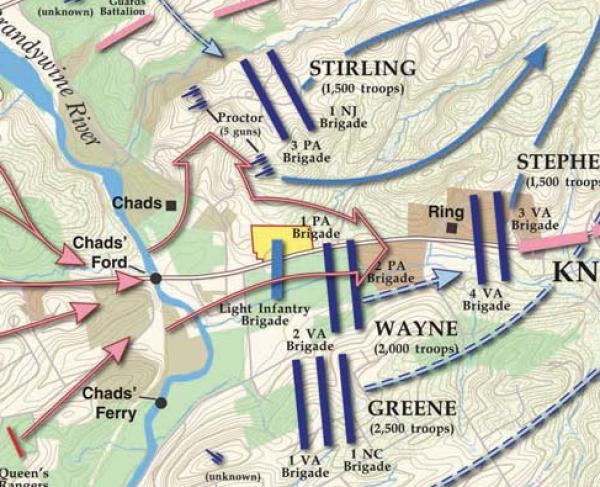Guilford Courthouse | Mar 15, 1781
In the weeks following the defeat of Lt. Col. Banastre Tarleton’s force at Camden, Major General Nathanael Greene and British General Charles Lord Cornwallis initiated a series of marches that carries the two armies out of South Carolina, into North Carolina, and then into a race to the Dan River in southern Virginia. In early March, thousands of militia from Virginia and North Carolina, joined Greene’s growing army in southern Virginia. In the second week of the month, Greene marched his army of 4,500 back into North Carolina. Meantime, Cornwallis had cut away from his own supply line to live off of the land as he pursued Greene through North Carolina. The choice was a poor one, as the Tory forces moved through and are already picked clean by the Rebels. With Greene moving back into North Carolina, Cornwallis sought an immediate battle.
On March 15, 1781, Greene arrayed his arrayed his army for battle near the Guilford Courthouse (modern day Greensboro, North Carolina). Utilizing similar tactics to Morgan at Cowpens, Greene set his men in three lines. The first line consisted of North Carolina militia, bolster by two cannon, riflemen, and dragoons on the respective flanks. The second line consisted of Virginia militia. The third and final line was the backbone of the army-Virginia, Delaware, and Maryland Continentals and eventually four cannon.
Although his army was outnumbered by a factor 2-to-1, Cornwallis went on the offensive. After a morning clash between the legions Tarleton and Col. Henry Lee, Cornwallis deployed his army in two lines, with the bulk of his men in the first line, and clashed with Greene’s army on the late morning of March 15. Roughly 40 yards from the American first line, the North Carolina militia opened fire in one grand volley. The British line was staggered, but pushed forward in pursuit of the now fleeing Tar Heels as the flanking units sparred with the American riflemen, who opened and disjointed the British lines.
Entering a wood line, the disjointed British line met the second line of Rebel resistance, the Virginia militia. For perhaps thirty minutes, knots of combatants battled it out in the woods near Guilford Courthouse. Confusion reigned on parts of the line. Americans mistook Hessians as their own Continentals, allowing the Hessians to closely approach and fire deadly volleys into the Virginians. Patriot forces gave ground reluctantly, but their staggered defense slowed and broke up the British ranks.
Cornwallis and his men finally reached the third American line. In piecemeal fashion, the redcoats thrust their attack uphill into Greene’s Continentals. A Maryland Continental regiment broke, and a melee ensued as Continentals and the elite units of Cornwallis’s army battled it out. William Washington’s Dragoons entered the fray and vicious hand to hand combat ensued. Greene had seen enough. Wanting to preserve his core of Continentals, he withdrew his army in good order. The redcoats could not pursue. Although victorious, the Pyrrhic victory cost Cornwallis 28% of his army, and the hard campaign had taken its toll on the British. A few days later, Cornwallis marched his army to the Cape Fear River and Wilmington. After experiencing the obstinate nature of patriots in the Carolinas, Cornwallis set his sights on the richest of the Southern colonies, Virginia.
Related Battles
1,310
532





